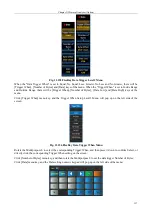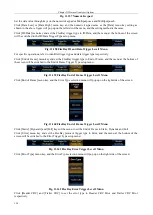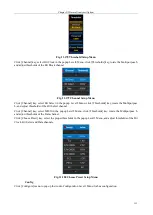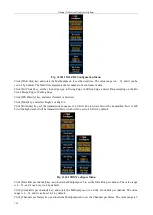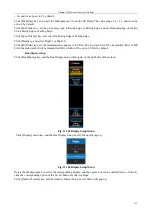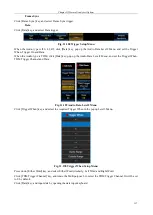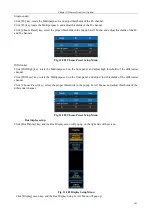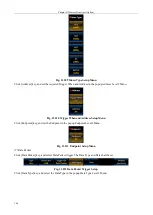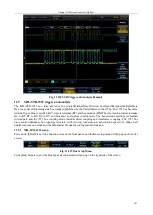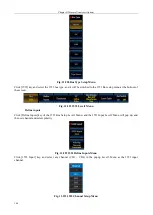
Chapter XI Protocol Analyzer (Option)
135
~ 64, and it can be set to 2 by default.
Click [Bit Delay] key, and rotate the Multipurpose b to set the Bit Delay. The value range is 0 ~ 31, and it can be
set to 0 by default.
Click [Bit Clock] key, set the clock edge type to Rising Edge or Falling Edge, and set Data sampling on the Bit
Clock Rising Edge or Falling Edge.
Click [Sync Polarity] key, and select the Rising Edge or Falling Edge.
Click [Data] key, and select High=1 or High=0.
Click [Bit Order] key, set the transmission sequence to LS First (the low data bit will be transmitted first) or MS
First (the high data bit will be transmitted first), which will be set to LS First by default.
Bus display setup
Click [Bus Display] key, and the Bus Display menu will pop up on the right side of the screen.
Fig. 11.183 Display Setup Menu
Click [Display] menu key, and the Bus Display Setup Level3 Menu will pop up:
Fig. 11.184 Display Setup Menu
Rotate the Multipurpose b to select the corresponding display, and then press it down to confirm Select, or directly
click the corresponding option of the Level3 Menu for direct settings;
Click [Number Format] key, and the Number Format Setup Level3 Menu will pop up:
Summary of Contents for 4456 Series
Page 10: ...VIII...
Page 55: ...Chapter V Trigger System 45 Fig 5 51 RF Test Signal Example...
Page 69: ...Chapter VII Mathematical Operation 59 Fig 7 10 Advanced Math Example...
Page 71: ...Chapter VIII Display System 61 Fig 8 3 Wfm Palette Menu Fig 8 4 Normal Palette...
Page 72: ...Chapter VIII Display System 62 Fig 8 5 Inverted Palette Fig 8 6 Temperature Palette...
Page 75: ...Chapter VIII Display System 65 Fig 8 12 XY Display Example...
Page 165: ...Chapter XI Protocol Analyzer Option 155 Fig 11 242 1553 Trigger and Analysis Example...







